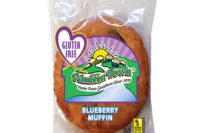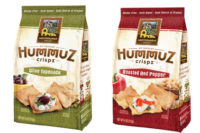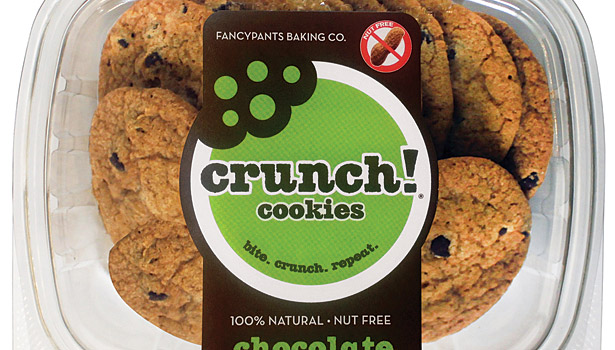State of the Industry: Cookies shift into overdrive
















Our 2013 State of the Industry report explores market information for the bread aisle, sweet goods, cookies, bars, snack cakes, frozen baked goods, tortillas, pies and more.
Holding the lead in the sweet snack race, cookies, like other bakery categories, are undergoing a healthy transformation that incorporates natural ingredients, super foods and clean labels.
Despite what some may consider a mature market, the cookie segment, like a tenacious racecar driver, has been bump-drafting its way back on top with innovative flavors, cleaner labels and convenient packaging.
It hasn’t been easy avoiding the dusty air from the multitude of snack items continuously motoring into the marketplace. “We saw an interesting evolution last year within the snacking industry, as two historically separate macro trends merged to create a mega trend—demand for affordable luxuries and sensitivity to healthy food choices,” says Matt Duffy, director of marketing for Nonni’s Foods, LLC, Oakbrook Terrace, Ill. “A shift in consumer eating habits has contributed to the growth of the snack market. American consumers have increased their snacking occasions and now look toward packaged food companies to not only offer convenient products and satisfying ingredients, but healthier options to meet their cravings.”
Rather than feeling the drag from healthier snack options, cookie manufacturers have shifted into high gear. “Better-for-you products are a huge opportunity within the grocery channel that will help drive sales to the cookie category by sourcing consumption and sales from a combination of other categories, including fresh fruits, nuts and crackers,” Duffy says.
In the 52 weeks ending April 13, 2013, sales in the cookies/ice cream cone category increased 3.5% compared with the year prior, totaling more than $6.8 billion in all retail channels, according to The Nielsen Co., a New York City-based research firm. The category grew almost 10% from 2010 to 2013.
A healthy groove
As in past years, healthier ingredients remain a major focus of the cookie segment, almost as much as taste, as consumers seek cookies as an indulgence.
“Keebler firmly believes that consumers want cookies to be cookies,” says Phil Singh, associate director of Cookies and On-The-Go Innovation at Kellogg Co., Battle Creek, Mich. “If a cookie doesn’t taste good, or if there are taste trade-offs that are being made to deliver a healthier cookie, consumers will not come back to the product.”
Kellogg’s research strongly indicates that consumers are looking for simple, recognizable ingredients in their foods. Addressing this feedback, the company recently launched its Simply Made cookie line, which features a cleaner label.
Demand for high-quality ingredients is driving sales for a number of specialty cookie brands, especially within the club channel. “Wholesome snacks that taste great and that people can feel good about are in,” Duffy says. “Consumers are reading product labels more closely, and we are seeing the effects of a simple food movement when it comes to ingredients.”
As part of the clean-label movement, there also has been a shift away from artificial flavors and colors toward all-natural sweeteners. “Cleaner ingredients are an overall trend,” says Robert Dalson, national sales manager at Torn Ranch, Petaluma, Calif. “The focus is on removing artificial sweeteners and flavors and adding more organic ingredients.”
As consumers’ perceptions shift to a less-is-more mentality, they’re seeking products made with whole, real ingredients that are visible. “The cookie segment in general is about manufacturers cleaning up their products,” says Joanne Adirim, CEO of Gardena, Calif.-based HannahMax Baking. “We’re seeing cleaner, simpler ingredients because consumers are demanding better quality and are more conscientious in what they’re eating.” The company’s new Crunchy Cookie Chips are made with clean ingredients and contain no trans-fats.
The cleaner labels trend extends toward the absence of high fructose corn syrup and allergens in more product lines. In this realm, the focus has been on eliminating gluten and nuts. “We’re seeing major sales growth, due to buyers searching for allergen-friendly products,” says Justin Housman, founding partner of Fancypants Baking Co., East Walpole, Mass. “The push toward nut-free offerings has definitely increased, due to greater publicity and the fact that school districts across the country are beginning to ban food products that may contain nuts.”
Fancypants operates a dedicated peanut- and tree nut-free facility. It has focused on the healthful trend as well, offering Crunch! Cookies that are 100% natural and 50 calories per serving.
“In the past year, consumers have focused on high fructose corn syrup as something they want to avoid or at least monitor,” says Dave Leyrer, cofounder of Skeeter Snacks in Westport, Conn. “For what we do, the highest form of healthfulness is safety—great ingredients, all-natural, no trans-fats and no high fructose corn syrup. Those things are clearly very important to our consumer but secondary to safety.” Geared to kids and adults, Skeeter Snacks Cinnamon Grahams and Chocolate Chip Minis both are nut-free, made with whole grain and contain zero trans-fat or high fructose corn syrup.
Also focusing on healthful ingredients, Athena’s Silverland Desserts, Forest Park, Ill., recently added a White Chocolate Blueberry cookie to its all-natural line. “The greatest growth opportunity is the use of up-and-coming superfoods like turmeric and natural, organic, local and sustainable ingredients,” says Leila Uslander, the company’s director of marketing.
Superfoods speedway
Like more healthful ingredients and cleaner labels, innovative flavors are the gasoline in the cookie sales engine. One of the most popular flavors injecting fuel into this category is dark chocolate in this category is dark chocolate.
In 2012, Kellogg Co. expanded its Keebler Fudge Stripes line with a Dark Chocolate Fudge version and continues to expand its Jumbo Fudge Sticks with a Mint flavor and the recent addition of Dark Fudge. In addition to growing its Sandies platform with a Toffee flavor in 2012, Kellogg introduced a Cinnamon Rolls Cookies line cobranded with Cinnabon.
“We also went back into the Keebler vault to bring back Pitter Patter, a peanut butter sandwich cookie that first was produced in 1971,” Singh says. “In addition, we reinvigorated our Chips Deluxe platform with Triple Chocolate and, as part of our Hispanic focus, we launched El Duende cookies, which focus on those customers and markets with high indexes of Hispanic shoppers.”
Also capitalizing on the popularity of dark chocolate, HannahMax recently introduced a dark chocolate chocolate chip version of its Crunch Cookie Chips line, which is available in original, chocolate chip, cinnamon sugar and sea salted peanut butter varieties. “People like crunchy and texture,” Adirim says. “We are seeing more mixing of sweet and savory, which includes unusual combinations of sweet and spicy ingredients.”
Fancypants is going for that crunchy texture with four recently launched seasonal varieties in the Crunch! line: Pumpkin Chocolate Chip, Apple Cider, Peppermint Chocolate and Eggnog.
“Last year, confectionery trends focused on elevating product lines with trendy flavor introductions, whether they were globally inspired or perfectly paired,” says Duffy. “This year, customers are still searching the shelves for indulgent flavors but with the blend and appeal of healthy, whole ingredients.”
Nonni’s includes whole foods in its biscotti, including real eggs, butter, gourmet bittersweet chocolate, whole cranberries, raisins, almonds and pistachios. “This smart indulgence [mentality] has bolstered new product demand and sales growth in several areas and the trend remains strong for 2013,” Duffy says.
Introduced last summer, Nonni’s THINaddictives are twice-baked almond thins that include healthy ingredients, such as real whole cranberries, raisins and pistachios. The line is available in three varieties: Cranberry Almond, Cinnamon Raisin Almond and Pistachio Almond.
In a search for unique flavor profiles, Torn Ranch has developed its Fudge Nut cookie line and will soon unveil a peanut butter cookie. “Our Oatmeal Currant cookies and Snappy Ginger cookies are popular,” Dalson says.
No-pass packaging
When it comes to the most popular cookie packaging, like NASCAR haulers, convenience is paramount. “Convenience is important for today’s American consumer and their busy lifestyle,” Duffy says. “For this reason, single-serving, portion-controlled packaging complements this standard of living.”
Although not a new development, portion control continues to be prevalent in the cookie segment, as more consumers eat meals and snacks on-the-run, while also trying to watch their weight. Individually-wrapped products enable them to do both anytime, anywhere.
Nonni’s traditional, full-size biscotti has always been individually-wrapped to broaden appeal and usage occasions beyond traditional cookies, sourcing volume from the snack bar category. The company’s THINaddictives follow suit with 100-calorie, pre-portioned packs. Meanwhile, Nonni’s new bite-size Biscotti Bites combine the delicate flavors of biscotti and chocolate and come in 7-oz. snack bag that’s easy to bend, fold and transport.
Small tweaks in packaging can maintain product freshness, while meeting consumer demand for convenient, on-the-go snacking. The challenge of packaging innovation in the cookie category is to deliver a simple, mess-free solution for parents and kids, Singh says. “That includes executions that are easier to eat and also easier to carry,” he explains. “We call that being purse-safe and backpack-ready.”
Some contend that today’s consumer products goods (CPG) companies are beginning to take design cues from some of the high-end aspirational brands in other categories, such as Apple, Audi and Tesla, by incorporating upscale packaging elements into everyday items, such as restrained elegance.
“That’s not the right direction for us, though,” Leyrer says. “We like the retro vibe of the old-style, character-driven packaging, which draws inspiration from [traditional cartoons]. Our customers start as kids and frequently groups of kids, since we get a lot of bulk orders from schools, camps, YMCAs, teams, etc. We want our consumers to have a fun, sentimental feel about our brand, especially because, unlike some other allergies, the vast majority of those with nut allergies won’t outgrow them in adolescence.”
Alternative closure styles also are on the horizon. In recent years, resealable pouches for cookies have been popular, due to their added convenience and portion-control properties. “We are getting a lot of requests for 1- and 2-oz. snack bags, which we will be launching this year,” Adirim says. “We also are looking at utilizing robotics for packaging our products.”
Says Dalson, “Because bags and cartons remain the traditional packaging format, we came out with new cookie packaging last year, staying within the carton format but with a different closure style. People know our brand from the look of the packaging.”
Environmentally-friendly packaging options are also being used more widely. “Greener options will be the packaging trends of the present and the future,” Housman says. “We use PET plastic clamshells made from 100% recycled materials, which are more expensive, but well worth it, considering their decreased impact on the environment and the positive response we get from consumers.”
The finish line
Heading into the home stretch, manufacturers predict a continued focus on cleaner labels, healthier ingredients and allergen-free products in the cookie segment.
“It’s pretty simple,” Leyrer explains. “We’re addressing only the most common, fastest-growing and among the most lethal allergies and limiting them. We’re able to deliver products at mainstream prices, with the taste that will appeal to the whole family, group, class or team etc. Over time, being nut-free will become a baseline criteria for mainstream snacks.”
Like bread, buns and rolls marketers, cookie marketers say the segment will need to evolve with consumer demand. “We will continue seeing the traditional cookie segment grow stronger with the increase of organic and clean ingredients and more whole food or superfood cookies similar to the breakfast bar industry,” Dalson says. “This will morph into making cookies healthier and, at some point, include supplements, [like vitamins].”
Because the cookie segment is variety-driven, consumers are always looking for cookies that are unique and exciting. “We see a key trend in the on-the-go section, which is typically shelved with or next to cookies at most retailers,” Kellogg’s Singh says. “In the past 12 months, more than 60% of category growth has come from on-the-go, and we only see that trend accelerating.”
Rising commodity prices, a recessive economy and increased consumer demand in ingredients and packaging have limited the industry’s profit share. However, these factors also have the potential to put cookie snacking in poll position.
“More Americans are now living hectic lifestyles, which will lead to higher frequency snacking to accommodate time restraints for traditional meals,” Duffy says. “On the other hand, a recovering economy would increase spending and consumption. This is where health and convenience trends will draw attention and increasing demand.”
Recognizing market factors and responding intuitively to new consumer demands is the key to future industry success. “For brands that have created Americans’ favorite snacks for decades, it’s challenging to not lose sight of the original product’s foundation,” Duffy says. “When innovating a product to replicate a superfood, it’s critical that producers maintain the integrity of the product’s founding values. It’s difficult to transform a product’s makeup and ensure that consumers still come back for the taste they know and love.”
Looking for a reprint of this article?
From high-res PDFs to custom plaques, order your copy today!













